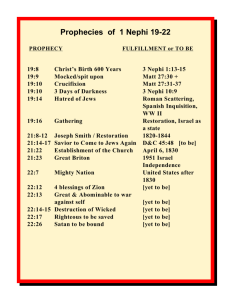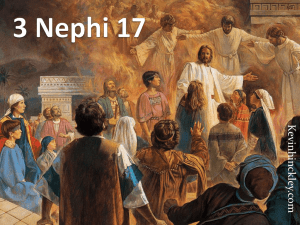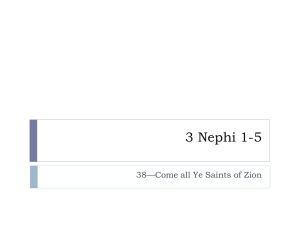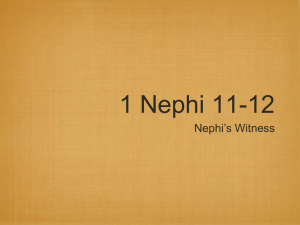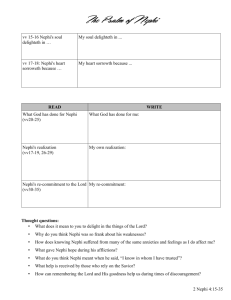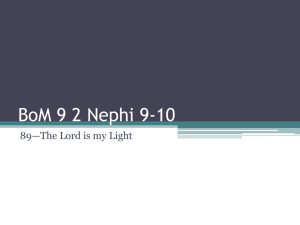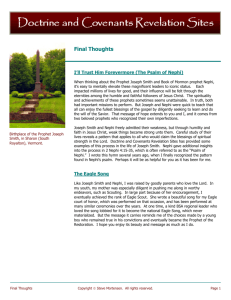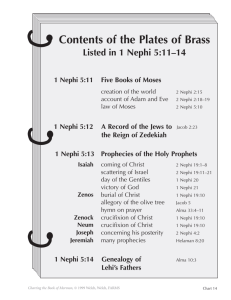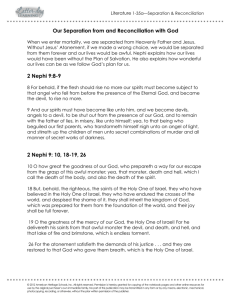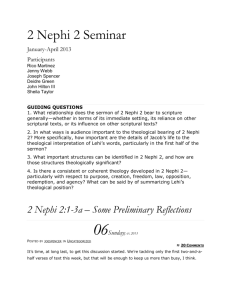When Does the Book of Mormon First Talk about the Plan
advertisement
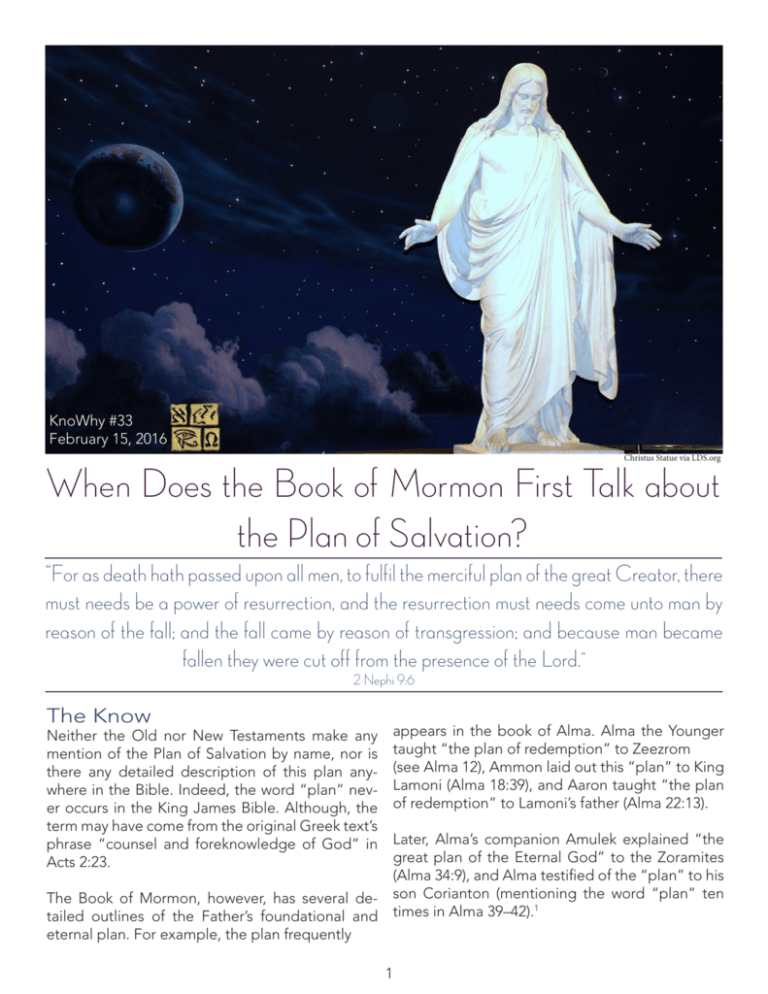
KnoWhy #33 February 15, 2016 Christus Statue via LDS.org When Does the Book of Mormon First Talk about the Plan of Salvation? “For as death hath passed upon all men, to fulfil the merciful plan of the great Creator, there must needs be a power of resurrection, and the resurrection must needs come unto man by reason of the fall; and the fall came by reason of transgression; and because man became fallen they were cut off from the presence of the Lord.” 2 Nephi 9:6 The Know Neither the Old nor New Testaments make any mention of the Plan of Salvation by name, nor is there any detailed description of this plan anywhere in the Bible. Indeed, the word “plan” never occurs in the King James Bible. Although, the term may have come from the original Greek text’s phrase “counsel and foreknowledge of God” in Acts 2:23. appears in the book of Alma. Alma the Younger taught “the plan of redemption” to Zeezrom (see Alma 12), Ammon laid out this “plan” to King Lamoni (Alma 18:39), and Aaron taught “the plan of redemption” to Lamoni’s father (Alma 22:13). Later, Alma’s companion Amulek explained “the great plan of the Eternal God” to the Zoramites (Alma 34:9), and Alma testified of the “plan” to his The Book of Mormon, however, has several de- son Corianton (mentioning the word “plan” ten 1 tailed outlines of the Father’s foundational and times in Alma 39–42). eternal plan. For example, the plan frequently 1 While Alma, the High Priest of Zarahemla, made great use of the doctrine of the plan, he was not the first Nephite priest to do so. The first explicit exposition of the plan was made much earlier by Jacob, Nephi’s younger brother and first priest of the temple in the city of Nephi. Jacob called it “the merciful plan of the great Creator,” and “the plan of our God” (2 Nephi 9:6, 13). As Jacob described, the plan goes back to the very beginning, centering around “the great Creator” who would allow “himself to become subject unto man in the flesh, and die for all men, that all men might become subject unto him” (2 Nephi 9:5). This would be “an infinite atonement” because “save it should be an infinite atonement this corruption could not put on incorruption” (2 Nephi 9:7). As Jacob concluded this part of his covenant speech, he explained that at the judgment, “they who are righteous shall be righteous still, and they who are filthy shall be filthy still.” The filthy “shall go away into everlasting fire, prepared for them” (2 Nephi 9:16). Meanwhile, “the righteous, the saints of the Holy One of Israel, they who have believed in the Holy One of Israel, they who have endured the crosses of the world, and despised the shame of it, they shall inherit the kingdom of God, which was prepared for them from the foundation of the world, and their joy shall be full forever” (2 Nephi 9:18). Tracing Jacob’s understanding of the plan back one generation earlier, it appears that his inspired summation carried forth the influence of his father’s instructions to him in 2 Nephi 2. Although Lehi never called it a “plan,” he taught these same An atonement was necessary, Jacob explained, doctrines in his final blessing to Jacob. In that fabecause “death hath passed upon all men” and ther’s blessing, Lehi taught, “the way is prepared thus, “there must needs be a power of resurrec- from the fall of man, and salvation is free” (2 Nephi tion.” This mortal state came about “by reason of 2:4). He explained the atonement, that the Holy the fall” (2 Nephi 9:6). Messiah “offereth himself a sacrifice for sin” and “layeth down his life according to the flesh, and Without an atonement, the effects of the fall would taketh it again by the power of the Spirit, that he “have remained to an endless duration” meaning, may bring to pass the resurrection of the dead, “flesh must have laid down to rot and … to rise no being the first that should rise” (2 Nephi 2:7–8). more” (2 Nephi 9:7). Jacob further explained that without a means of redemption would leave “our Lehi further explained the coming judgment, notspirits … subject to that angel who fell from be- ing that after the resurrection, “all men come unto fore the presence of the Eternal God, and became God; wherefore, they stand in the presence of him, the devil.” In other words, without the atonement to be judged of him according to the truth and hoand we would become like that fallen angel liness which is in him” (2 Nephi 2:10). Lehi taught (2 Nephi 9:8–9). that there are ultimately two outcomes, “liberty and eternal life, through the great Mediator of all But God’s merciful plan of salvation, redemption, men” or “captivity and death, according to the and happiness provides “a way for our escape from captivity and power of the devil” (2 Nephi 2:27). the grasp of this awful monster; yea, that monster, death and hell” (2 Nephi 9:10). That escape is Lehi is also the one who taught Jacob “that an through the atonement, which forces death and angel of God, according to that which is written, hell to “deliver up their dead” “by the power of had fallen from heaven; wherefore, he became a the resurrection of the Holy One of Israel” devil, having sought that which was evil before (2 Nephi 9:12). God” (2 Nephi 2:17), and that “he seeketh that all men might be miserable like unto himself” (2 NeAfter this, “they must appear before the judgment- phi 2:27). These and others are the same doctrines seat of the Holy One of Israel; and then cometh taught by Jacob as “the merciful plan of the great the judgment, and then must they be judged ac- Creator” (2 Nephi 9:6). cording to the holy judgment of God” (2 Nephi 9:15). 2 Though they taught the same doctrines, Lehi’s emphasis was focused more on the fall, opposition, and the agency afforded to all to choose between good and evil. Jacob, meanwhile, put more emphasis on the atonement, resurrection, and the eternal outcome from choosing either righteousness or filthiness. Alma, reflecting the needs of his time, emphasized repentance, redemption, justice and mercy, and the resultant happiness that the righteous will enjoy in the rest of the Lord. Latter-day Saint temples today continue to be places that teach God’s eternal plan for his children. Everything in the temple—from the architecture to the instructive dramatizations, to the covenantal ordinances preformed there—teaches and makes effective the Plan of Salvation. Jacob’s role as priest gave him special insights and responsibilities to administer these doctrines. At the same time, we recognize that different Book of Mormon writers taught the plan differently. Even when comparing the teachings of a son The Why Comparing the teachings of Lehi, Jacob, Alma with the counsel given to him by his father, we find and other Nephite leaders is instructive. We learn that each has a different emphasis. The differences that, although Jacob was the first to use the word likely stem from the circumstances in which their plan to describe the relationship between the cre- respective blessings or discourses were given. ation, fall, and atonement, he was not the first to For instance, Lehi’s blessing was given to a son understand that relationship. whose older brothers had provided completely Understanding this interrelationship came to Lehi opposing models for how to live. No wonder Lehi through revelation, especially as he was admit- focused on agency, opposition, and the conseted into the heavenly council and was allowed to quences of sin. Jacob, meanwhile, was a temple read the heavenly book setting forth the plan, the priest, likely4speaking to his people on the Day of judgments, and the mercies of God (see 1 Nephi Atonement. His emphasis on the Messiah’s atone1:8–19). Jacob passed this sacred knowledge on, ment, therefore, is also only natural. just as his father Lehi had blessed him to (see 2 In sum, we get a complete view of the plan when Nephi 2:8). we study Lehi and Jacob together. Adding Alma, The doctrines of the great plan may have been es- Amulek, Ammon, Aaron, and others provides a yet pecially important to Jacob. These teachings were fuller picture of the Lord’s eternal plan of mercy, the final testament he personally received from his justice, redemption, salvation, love, and happifather before he passed away.2 Jacob would still ness. This continues as we move on into modern have been relatively young when he lost his father revelation and other restoration texts which clarify to death, and for this reason, he may well have es- important parts of the plan, such as the premorpecially treasured these precious teachings and tal life and the degrees of glory (see Doctrine and took the greatest care to pass them along to his Covenants 76; Moses 4; Abraham 3). people. Moreover, the awareness and portrayal of the plan are also related to the temple. The temple in Jerusalem was the background for Lehi’s prophetic counsel to his sons;3 and Jacob and Alma were responsible for the temples in the cities of Nephi and Zarahemla, closely aligning their teachings with their high priestly duties. Having access to the fullness of the Plan of Salvation is one of the most profound and distinctive blessings that sets Latter-day Saints apart from the world. It is the Book of Mormon that, first and foremost, repeatedly lays out the foundational doctrines of the Father’s plan. Making this Plan of Salvation known is one of the things the Book of Mormon does best. 3 Further Reading Book of Mormon Central, “Did Jacob Refer to An- Gerald N. Lund, “Plan of Salvation, Plan of Recient Israelite autumn Festivals?” (2 Nephi 6:4),” demption,” in Encyclopedia of Mormonism, ed. Daniel H. Ludlow, 4 vols. (New York, NY: MacmilKnoWhy 32 (February 12, 2016). lian Publishing, 1992), 3:1088–1091. Book of Mormon Central, “How Did Lehi Learn So Much About the Fall? (2 Nephi 2:25),” KnoWhy 28 Robert J. Matthews, “The Atonement of Jesus Christ: 2 Nephi 9,” in Second Nephi, The Doctri(February 8, 2016). nal Structure, ed. Monte S. Nyman and Charles M. Catherine Thomas, “Plan,” in Book of Mormon D. Tate Jr. (Provo, UT: Religious Studies Center, Reference Companion, ed. Dennis L. Largey (Salt Brigham Young University, 1989), 177–199. Lake City, UT: Deseret Book, 2003), 642–643. © Book of Mormon Central, 2016 NOTES 1. See Alma 39:18; 41:2; 42:5; 42:8, 11, 13, 15 (2x), 16, 31. Ten was an important number in both the Bible and the Book of Mormon, where it often signified perfection or completeness. See John W. Welch, “Counting to Ten,” Journal of Book of Mormon Studies 12, no. 2 (2003): 42–57, 113–114. 3. See Book of Mormon Central, “How Did Lehi Learn So Much About the Fall?” (2 Nephi 2:25),” KnoWhy 28 (February 8, 2016). 4. See Book of Mormon Central, “Did Jacob Teach About Ancient Israelite Autumn Festivals?” (2 Nephi 6:4),” KnoWhy 32 (February 12, 2016). 2. For Lehi’s blessings as a “testament,” see Book of Mormon Central, “Should 2 Nephi Chapters 1–4:12 be Called the ‘Testament of Lehi’? (2 Nephi 3:3)” KnoWhy 29 (February 9, 2016). 4
